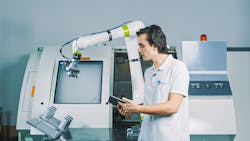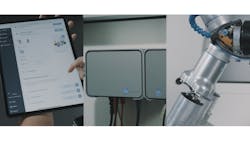New Era of Collaborative Automation Deployments are Application-Focused and Programming-Free
Robot programming has come a long way. Today, there are various approaches, from simple hand-guiding all the way to leading-edge platforms that achieve next-level usability by eliminating programming altogether.
Combined with the growing trend towards open, plug-and-play hardware, these new, simpler approaches to automation deployments not only make robotics more accessible to small and medium-size (SME) companies, but they also help to address the labor and skills shortages being experienced by both manufacturers and integrators.
Every improvement in the usability of collaborative automation plays its part in reducing deployment lead times and costs. This greater efficiency enables integrators to take on more work and minimize reliance on expert robot engineers to get applications up and running.
Simplicity Boosts Cobot Adoption
Collaborative automation is now the fastest growing segment of the industrial robot market. Cobot-based systems are attractive to companies of all sizes thanks to their affordability, fast ROI, small footprint and ability to switch between different products and applications. Most of all, collaborative automation breaks down the traditional barriers to automation adoption experienced by SMEs.
Deploying traditional industrial robots is a costly and time-consuming process that requires robotics engineers with in-depth knowledge of a variety of robot systems and programming languages. This complexity ensured that traditional industrial automation remained beyond the budgets and competencies of SMEs.
READ MORE: Barely There: Replacing Manual Operations with Lights-out Processes
Collaborative automation, to varying degrees, breaks down this complexity through a range of usability features that enable companies with little or no previous robotics experience to deploy automation quickly, safely and effectively.
User friendly interfaces and programming techniques are not just of benefit to end-users: Integrators also gain from technologies that reduce deployment lead times and costs. The culmination of these trends and advancements in usability is fully automated deployment and programming.
Programming-free deployment liberates integrators from a wide range of tedious manual processes and provides a giant leap in usability that makes collaborative industrial automation deployments faster and easier than ever before.
Guided by Hand
Many leading cobot brands provide hand-guiding features designed to speed up the deployment process. Instead of spending time on complex, solely pendant-based programming, cobot users can program the system by guiding the robot and end-effector into position by hand and setting various points along the way. This intuitive programming method saves time and money by reducing project complexity.
Reducing Complexity Builds Comfort
Traditional, pendant-based industrial robot interfaces are notoriously difficult for non-experts to operate. That’s because they were designed for robotics engineers, not SMEs with limited robotics experience. Leading collaborative automation systems have replaced those clunky interfaces with intuitive, user-friendly interfaces that reduce deployment times.
READ MORE: Automated Factories: A Discussion on Challenges in Automation
When SMEs need to quickly redeploy collaborative automation to meet labor gaps, handle product changes or sudden fluctuations in demand, it’s a comfort to know that programming can be achieved via familiar interfaces. That familiarity extends to other devices, too—some cobot application solutions are programmed primarily via tablets, laptops and smartphones. These approaches reduce redeployment lead times, which empower SMEs, but also enable integrators to complete deployments effectively and quickly.
Plug & Play Hardware
What’s even better than usability feature enhancements across individual cobot brands? Cross-platform systems that enable speedy deployments across multiple cobot brands. This so-called “one system, zero complexity” philosophy supports easy programming across a wide range of cobots and across a range of collaborative application domains from machine tending to pick & place operations. By providing a unified mechanical interface and communication standards across robot brands, this approach enables scalable automation expansion.
Limited Programming Systems
Designed to simplify deployments of collaborative systems, so-called “low/no-code programming” approaches typically incorporate visual modeling and drag-and-drop user interfaces. Little programming knowledge is required to operate these systems, especially if the application is an extremely simple one. If, on the other hand, the application is complex, some programming knowledge is typically required to ensure a safe and successful deployment.
New Era of Automated Deployments
We’ve covered the main trends and incremental improvements in usability, but the latest and greatest—and the culmination of all these trends—is a new application-specific platform that eliminates the need for programming altogether. This is not easy programming, less complex coding or no code programming, but a platform that requires no programming at all.
This approach fully automates the process of building, running, monitoring and re-deploying collaborative automation. Complete applications, such as machine tending and palletizing, can be deployed and redeployed directly on the manufacturing floor in a few simple steps—and with zero programming required.
The usability features we’ve looked at so far have been incremental from better interfaces, and more intuitive programming techniques to reduced programming requirements. The elimination of programming is a completely different proposition and one that brings exceptional time savings versus traditional automation deployment techniques. The result is a leap in usability that’s comparable to the industry-changing emergence of the first commercial collaborative robot systems.
READ MORE: Automate 2023: A Robotics & Automation Event Organized Around Market Trends
For example, deployment of a collaborative palletizing application using traditional methods typically takes an integrator around 40 hours. Using the new solution, the entire deployment takes around four hours—a 90% time savings. Similarly, a collaborative CNC machine tending application that typically takes 36 hours using traditional deployment approaches, takes just six hours when the deployment process is automated. And, when production requirements change, automated deployments provide the flexibility to enable quick re-deployments for new products or workpieces.
During cell setup, the platform automatically discovers most of the installed hardware and configures interfaces, providing immediate control. It then automatically generates the robot motion based on the obstacles and cell boundaries defined in the workspace. The program logic, signals exchange, event handling and robot movement are then automatically created for the entire application based on a few inputs.
Once the setup is completed, users simply click to run the application and can then remotely monitor performance indicators in real time to boost productivity and minimize downtime. Complete applications can now be developed and deployed on the factory floor in just a few simple steps. And the platform provides the flexibility and speed to enable lightning fast re-deployments when production requirements change.
Automated deployments allow integrators to deliver more projects in less time, using existing resources. And the hours previously spent installing and programming different cell components can now be spent on other projects, allowing integrators to expand their business and serve more customers.
Moreover, integrators can use the new platform to unlock collaborative automation’s full market potential by enabling them to develop solutions specifically for SMEs—a largely untapped segment of the manufacturing sector. It’s estimated that a mere 1.5% of 9 million potential collaborative applications are being automated today.
Automated deployments present a huge opportunity for robotics integrators looking for ways to grow their customer base. Additionally, automated deployments enable integrators to take on smaller projects that may not have been financially worthwhile using alternative deployment strategies and approaches.
In addition, the new platform enables integration firms to overcome the challenges associated with finding and retaining engineers, including the time-consuming necessity of training engineers on various robotics languages and simulation tools every time a new member joins the team.
Leading collaborative automation companies have always been about empowering SMEs, democratization of robotics, and breaking down barriers around complexity and cost to create a more level playing field for companies of all sizes. This way of thinking ushered in a new era for the industrial automation sector.
By eliminating programming and repetitive manual steps, the new platform is similarly poised to redefine how we think about—and our expectations of—industrial automation.
Kristian Hulgard is general manager of the Americas division at OnRobot, a one-stop shop for collaborative and light industrial robot applications. Hulgard has been part of the collaborative robot market since its emergence and is a thought leader in cobot applications and activation of robots in the collaborative space.


